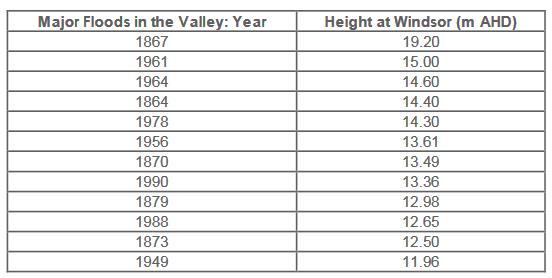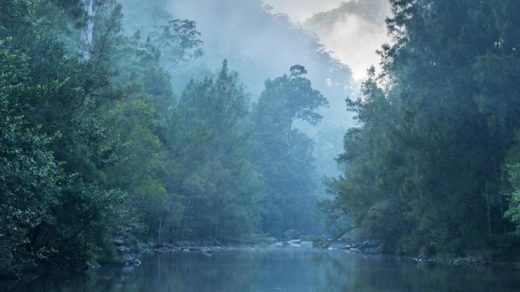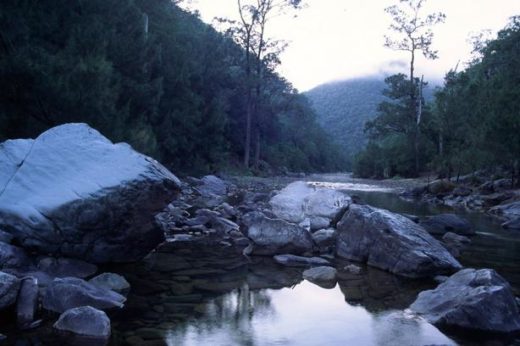Warragamba doubling exploits Climate Change
Tuesday, February 19th, 2019Climate Change orthodoxy a red herring of floodplain developers
When in doubt and keen to push one’s unjustifiable case, resort to the excuse of notional esoteric ‘climate change’ theory. It’s the contemporary dominant creed and orthodoxy, as if invoking God’s presence. One’s stance instantly becomes sacrosanct and any challenge to it is instantly dismissed as heresy.
The New South Wales (Sydney) government’s true justification to desire expanding the city’s drinking water reservoir at Warragamba Dam from 7500 hectares by another 4700 hectares (60%) to basically double the reservoir capacity.
It has nothing to do with climate change theorised flood mitigation.
It is everything to do with increasing drinking water storage capacity to cater for doubling the human population of the Sydney Basin from the current 5 million to a ludicrously intentioned plague of 10 million humans by 2036. Given the forecasters tend to understate for fear of alarming people, the likely timing will be more like 2030, just over a decade away.
Sydney’s Kurnell Desalination Plant of 2010 only supplies 15 percent of Sydney’s current drinking water needs, so as a guide, for about 750,000 residents.
Yet, in order to cater for a human plague of 10 million residents, another 5 million residents Sydney would need to have seven Kurnell type desalination plants if Warragamba Dam remained as it is. The seven would cost about $2 billion each to construct and another $500 million a year each to run, based on current financial reports. So in order to cater for this dystopian human plague projection, the capital cost of seven Kurnell desalination plants would be at least $14 billion, plus an further $3.5 billion to run them annually.
The New South Wales (Sydney) government’s 2018 surplus after paying for its expenses totalled $2 billion, and that was an exceptionally good year because it had a windfall of $4 billion from selling Snowy Hydro to the Federal Government. Yet it retained an $11 billion net debt.
So what this all adds up to is that Sydney cannot afford another 5 million residents financially. So the New South Wales (Sydney) government’s plan B is to futher degrade the environment by raising the Warragamba Dam Wall by 14 metres and so inundating 4700 hectares of Blue Mountains vital ecology and so annulling UNESCO-listed Greater Blue Mountains World Heritage.
All About Underpinning Exponential Urban Growth
Building Warragamba Dam was first mooted in 1845 when the population of the Sydney basin was approaching 50,000 people. A hundred years later, construction began in 1948 post World War II when Sydney’s population was approaching 1.5 million and mass immigration from Europe was in full-swing.
The Federal Government’s policy was to boost Australia’s population numbers in the interests of economic and military security. The first Minister for Immigration, Arthur Calwell, promoted mass immigration with the slogan “populate or perish” to overcome domestic resistance towards mass immigration. He coined the term “New Australians” to change Australian public negative perceptions.
The dam was completed in 1960 forming the reservoir artificially named Lake Burragorang with a capacity for 3 million tonnes of drinking water, by which time Sydney’s population had exceeded 2 million people, mainly from the federal mass immigration programme.
In order to safeguard the purity of the drinking water, a Special Area – No Entry has been extended for three kilometres from the top of the full storage water level in Lake Burragorang. The surrounding forested hills and rivers of the Blue Mountains were listed by UNESCO on 29 November 2000, cynically not for eucalypt protection, but to protect Sydney’s water supply.
Hawkesbury-Nepean flood risk beyond 1867 is scaremongering
Downstream from the Blue Mountains, the Hawkesbury-Nepean River is a major river system on the western outskirts of the Sydney Basin draining a catchment area of 22,000 square kilometres. Exceptionally heavy rainfall in this area can lead to severe flooding.
In 1867, a major rainfall event led to the river peaking at the colonial pastoral settlement of Windsor at 19.7 metres on 23rd June above the official Australian Height Datum (AHL, or basically mean sea level). The colonial township of Windsor was sensibly located an a hill rising up to 33 metres AHL, so was unaffected but the flood did however inundated the surrounding floodplain in which much of the farmland was flooded. Still twelve people died, many dwellings foolishly built in the floodplain inundated and hundreds of settlers made destitute.
Lessons learned by building on a floodplain in 2019?
‘House on the Rock’ parable:
“Everyone therefore who hears these words of mine, and does them, I will liken him to a wise man, who built his house on a rock. The rain came down, the floods came, and the winds blew, and beat on that house; and it didn’t fall, for it was founded on the rock. Everyone who hears these words of mine, and doesn’t do them will be like a foolish man, who built his house on the sand. The rain came down, the floods came, and the winds blew, and beat on that house; and it fell—and great was its fall.”
— Matthew 7:24–27, World English Bible (without endorsing religion).
Decades before, Governor Lachlan Macquarie had implored people to make their homes not on the river flats but on the high ground of the five ‘Macquarie towns’ he designated nearby. His advice was little heeded over following decades: people did not want to commute to their plots or have difficulty protecting their crops and livestock.
Over the following decades, population growth continued along the Hawkesbury, the area eventually becoming part of Sydney’s perpetuating endless sprawl.
By comparison, the 1961 flood peaked at only 15.1 metres, likely in part due to the Warragamba Dam upstream having been built the year prior. In August 1990 the Windsor level rose to 13.4 metres, then in 1992 to 11.0 m.
Windsor Flood Peaks above Average Height Datum:
 Source: SW SES, 2005, Hawkesbury/Nepean Flood Emergency Sub Plan, NSW State Disaster Plan.
Source: SW SES, 2005, Hawkesbury/Nepean Flood Emergency Sub Plan, NSW State Disaster Plan.
In 2005, the Sydney government announced plans to increase the drinking water capacity of Sydney with plans for the future of a city growing by 1,000 people a week, including western Sydney to build another wopping 160,000 houses and flats. A $1.4 billion plan was devised to secure Sydney’s water supplies for the next 25 years, including adding driving pumps into the deep water at the bottom of Warragamba and Avon dams; raising the Tallowa Dam wall on the Shoalhaven River, and constructing a pipeline to harvest surplus water from the Shoalhaven reservoir into the Warragamba reservoir.
In 2007, the Sydney government initiated a Hawkesbury-Nepean flood mitigation strategy involving building a high bypass bridge above the floodplain between Windsor and Mulgrave, costing $120 million, with its deck at a level equivalent to 17 metres at the Windsor gauge. The bridge is intended to make it possible to get the potentially trapped people of Windsor and surrounding areas, approximately 90,000 currently, to safety in the face of a severe flooding event.
In May 2017, the Sydney government then released its Hawkesbury-Nepean Valley Flood Risk Management Strategy – ‘Resilient Valley, Resilient Communities.’
The strategy is designed specifically for the valley as the most flood-prone region in the state of New Spouth Wales. It is a long-term plan to minimise significant risks to life and livelihoods; damage to urban and rural property; and, the major dislocation of economic activity from rapid, deep flooding.
After four years’ investigation, it recommended that raising Warragamba Dam by around 14 metres would be the best (cheapest) option to reduce the risks to life, property and community assets posed by floodwaters from the extensive Warragamba reservoir. Water NSW (recently renamed from Sydney Water) is the government agency that operates Warragamba Dam. It is charged to prepare a business case to raise the dam wall.
In June 2016 the then New South Wales Premier Mike Baird announced the Sydney government’s strategy to reduce the very significant flood risk in the Hawkesbury-Nepean Valley.
On 26th Oct 2018, the NSW the Berejiklian government passed its Water NSW Amendment (Warragamba Dam) Bill 2018, to amend the Water NSW Act 2014 to make provision with respect to the temporary inundation of national park land resulting from the raising of the wall of Warragamba Dam and the operation of the dam for downstream flood mitigation purposes.
The government has persisted with overstating and deliberately scaremongering the flood risk to the Hawkesbury-Nepean Valley’s community and economy.
The option of constructing a large-scale regional road package is estimated to costing many billions combined with significant development restrictions would be the only alternative to the Warragamba Dam raising and would not be as effective. This is in comparison to the estimated $690 million—in 2015 dollars—for the Warragamba Dam raising proposal.
Despite the Hawkesbury-Nepean Valley being a floodplain, the govermnent has pushed ahead with selling off and subdividing the floodplain with housng over-development as part of its Greater Sydney Region Plan and the Western City District Plan. The Sydney government will consider the business case for the dam raising in 2020, subject to the success of the environmental and planning approvals. Construction of the raised dam will take approximately four years to complete.
Well-founded opposition to bedamned dam raising obsession
Blue Mountains Labor MP Trish Doyle spoke against the bill in Sydney Parliament:
“I do not buy the line that raising the dam wall will mitigate flood risk in real terms for people living in the Hawkesbury region right now. All that it will do is justify a huge amount of new property development on land that should be left well enough alone. There are alternatives to dam wall raising, which this government has refused to consider implementing.” she said. “In the first place, the government could reduce the maximum allowable limit in Warragamba to provide overflow capacity during times of sustained rainfall and inflows to the Warragamba catchment area. This would require the supplementation of that lost water with the mothballed desalination plant that this government has allowed to fall into disrepair.”
Environmental groups, traditional owners, the Greens and Labor have roundly condemned the passing of legislation to allow flooding of Blue Mountains National Park upstream of Warragamba Dam. Others talk of threatened species such as the Camden white gum put at risk, as well as food sources and habitat for the Regent honeyeater; a rare bird under threat of extinction. Gundungurra woman Taylor Clarke explains their creation story will be impacted, as sacred sites will be flooded if the proposal goes ahead.
The NSW Greens have warned of a ‘Franklin Dam’ like campaign.
Greens Urban Water spokesman Justin Field said: “This will be Sydney’s ‘Franklin’ campaign to save the world heritage listed Blue Mountains and wild rivers like the Kowmung (pictured above); the irreplaceable Aboriginal heritage in the river valleys and the threatened and endangered species that rely on the area. “Make no mistake, even a temporary inundation of these hugely important, beautiful and sacred areas means the long-term destruction of its environmental and heritage values. There is little doubt the government will have a serious fight on its hands if it pushes ahead with the proposal,” he said.
Secret documents about Dam Raising agenda
The Colong Foundation for Wilderness Inc. through its ‘Give a Dam‘ campaign made freedom of information requests for NSW Government documents relating to the dam and the flood plain. They also applied for documents under the federal Environment Protection and Biodiversity Conservation act which revealed there would be “significant impacts” on threatened species in the Mountains, according to the federal environment department.
The secret documents have revealed that the Sydney government did not prioritise “major regional road evacuation options” in a recent flood strategy for the Hawkesbury-Nepean Valley, and that federal environmental experts now believe raising the wall will have “extensive and significant impacts” on Blue Mountains threatened species.
Colong’s campaigner Mr Harry Burkitt has said: “These previously confidential government documents (from May 2018) reveal the the Sydney government plan to place an additional 134,000 people at risk on western Sydney floodplains by not investing in much-needed flood evacuation infrastructure. The government is fixated on raising Warragamba Dam to justify the over development of western Sydney floodplains. There has not been a single flood expert in Australia who has advocated not constructing additional flood evacuation roads in the valley. The government is also ignoring clear SES advice that additional flood evacuation routes are needed.”
Associate Professor Jamie Pittock of the Australian National University said it appeared “none of the additional benefits of improved evacuation routes have been considered in the NSW Government’s flood strategy”.
In explaining why there were no major regional road options for the flood strategy the NSW Government’s document Resilient Valley, Resilient Communities Hawkesbury-Nepean Valley Flood Risk Management Strategy of May 2017 said road option packages were not found to be as effective as reducing risk to life as the dam-raising options. However road evacuation initiatives are currently being implemented to reduce risk during flood evacuation events.
Blue Mountains MP Trish Doyle said the information “just proves what Labor has been saying all along – the Liberal Government is using flood mitigation as a smokescreen to justify raising the dam wall and they will let property developers run wild.”
Minister for Western Sydney, Stuart Ayres, has been scaremongering positing that Climate Change could cause a 26 metre high “a catastrophic flood” in the fast-growing part of the city, which he is accelerating.
Yet the latest information uncovered by Colong and Give a Dam shows federal environment department advisors believe that the increase “is likely to have extensive and significant impacts on listed threatened species and communities and world and national heritage values of the Greater Blue Mountains World Heritage Area”. Mr Burkitt said it’s “compelling evidence for the Federal Environment Minister Melissa Price to refuse the dam proposal under federal environmental law … it should be shelved immediately”.
NSW Nature Conservation Council CEO Kate Smolski said the federal government has a responsibility to protect areas of national environmental significance, like the Blue Mountains. “Time and again it has handed assessment of major projects to the Berejiklian government, which has a record of putting development ahead of the environment. Putting the world heritage listing of an iconic site like the Blue Mountains at risk is unacceptable,” she said.
Further Reading:
[1] Warragamba Dam Raising Proposal (NSW Government – Sydney Water, Feb 2018), >https://www.habitatadvocate.com.au/wp-content/uploads/2019/06/Warragamba-Dam-Raising-Proposal-Sydney-Water-February-2018.pdf. Source: ^https://www.waternsw.com.au/__data/assets/pdf_file/0008/130499/FAQS_February2018.pdf
[2] Hawkesbury-Nepean Valley Flood Risk Management Strategy – FAQ (NSW Government Sep 2018), Document: >https://www.habitatadvocate.com.au/wp-content/uploads/2019/06/Hawkesbury-Nepean-Valley-Flood-Risk-Management-Strategy-–-FAQ-NSW-Government-Sep-2018.pdf. Source: ^http://www.infrastructure.nsw.gov.au/media/1723/warragamba-dam-raising.pdf
[3] Hawkesbury-Nepean Flood Plan (NSW Government – State Emergency Service, Sept 2015), Document: >https://www.habitatadvocate.com.au/wp-content/uploads/2019/06/Hawkesbury-Nepean-Flood-Plan-NSW-Government-Sept-2015.pdf. Source: ^https://www.ses.nsw.gov.au/media/1627/plan-hawkesbury-nepean-flood-plan-sept-2015-endorsed.pdf
[4] Hawkesbury-Nepean Valley Flood Risk Management Strategy – FAQ (NSW Government, Sep 2018), ^http://insw.com/media/1464/hawkesbury-nepean-flood-strategy-faqs-november-2017.pdf. Source: ^http://insw.com/media/1464/hawkesbury-nepean-flood-strategy-faqs-november-2017.pdf
[5] ‘Give a Dam‘ Protest Campaign, ^https://www.giveadam.org.au/about
[6] Kowmung River Kanangra-Boyd National Park Wild River Assessment (Parks and Wildlife Division, NSW Department of Environment and Conservation, June 2005, Document: >https://www.habitatadvocate.com.au/wp-content/uploads/2019/06/Kowmung-River-Wild-River-Assessment-NPWS-June-2005.pdf. Source: ^https://www.bluemountains.org.au/documents/gbmwha/kowmungwra08366.pdf
[7] ‘Council opposes raising Warragamba Dam wall‘, Blue Mountains Council, 20190131. Source: ^https://www.bmcc.nsw.gov.au/media-centre/council-opposes-raising-warragamba-dam-wall
[8] ‘Flooding 4000 hectares of National Park at Warragamba Dam won’t save Sydney from floods, says professor‘, 20181012, by , in The Land newspaper, (Australian National University Associate Professor Jamie Pittock claims the plan won’t make nearby residents safer and instead pointed to alternative options). Source: ^https://www.theland.com.au/story/5696040/flaws-in-nsw-dam-wall-plan-expert/
[9] ‘Water limits hit Sydney again‘, 20190528, by Andrew Clennell, NSW Political Editor, The Australian newspaper. Source: >https://www.theaustralian.com.au/nation/water-limits-hit-capital-again/news-story/e87f52de8cbe2315e8ad064b8d92c1d6
[10] Water NSW Amendment (Warragamba Dam) Bill 2018 (introduced into NSW Parliament by National Party’s Paul Toole 20181017 into the lower house, then by Nationals Niall Blair MLC in the upepr house 20180918). Document: ^https://www.habitatadvocate.com.au/wp-content/uploads/2019/06/Water-NSW-Amendment-Warragamba-Dam-Bill-2018.pdf. Source: >https://www.parliament.nsw.gov.au/bill/files/3553/Passed%20by%20both%20Houses.pdf













